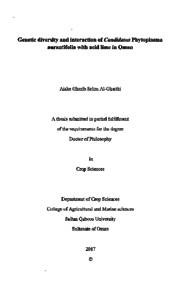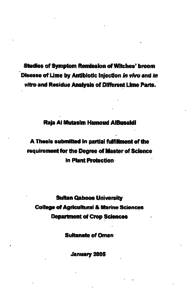وثيقة
Genetic diversity and interaction of candidatus phytoplasma aurantifolia with acid lime in Oman
الناشر
Sultan Qaboos University
ميلادي
2017
اللغة
الأنجليزية
الملخص الإنجليزي
Witches' broom disease of lime (WBDL), caused by 'Candidatus Phytoplasma aurantifolia', is a very serious disease of acid limes. This study investigated the distribution of phytoplasma and the expression of WBD symptoms in different geographical locations in Oman and UAE. Also, it investigated whether phytoplasma in locations where disease symptoms are expressed, are different from phytoplasma
in locations where disease symptoms are not expressed. Beside that the mineral contents in symptomatic and asymptomatic lime leaves were studied to see if there is any relationship between WBD development and mineral imbalance in limes. The survey showed that WBD symptoms were apparent in most locations (subtropical), except in desert (dry) and in the monsoon areas (semitropical). The symptoms were characterized by the mass production of branches and small light green to yellow leaves. However, 'Ca. Phytoplasma aurantifolia' was detected in acid lime in all the surveyed districts, including symptomless trees in desert and semitropical areas. Quantitative PCR analysis showed that the concentration of phytoplasma was significantly higher (8800-801 000 copies) in leaves developing WBD symptoms compared to 2–268 copies in symptomless leaves from the same trees and 8–874 copies in acid lime trees from areas where disease symptoms were not expressed.
Phylogenetic analysis of 15 phytoplasma isolates from treesdeveloping WBD symptoms and six phytoplasma isolates from trees with no WBD symptoms showed that all isolates shared an identical 16S rRNA sequence, belonging to subgroup II-B. Phylogenetic analysis of both genes imp and SAPII showed that the 21 strains were similar to each other and to reference strains in GenBank. The study showed that there was a low level of diversity among all phytoplasma strains. In addition, it showed that phytoplasma in places where witches' broom symptoms were not expressed were similar to phytoplasma in places where disease symptoms were expressed The study also compared the level of minerals in symptomatic acid lime leaves in comparison to asymptomatic leaves from the same trees and also to healthy trees. Mineral analysis revealed that the level of Na was significantly higher by four times in the symptomatic acid lime leaves compared to the non-symptomatic leaves and to the uninfected leaves. In addition, symptom development resulted in a significant increase in the levels of P and K by 1.6 and 1.5 times, respectively, and a significant decrease in the levels of Ca and B by 1.2 and 1.8 times, respectively. There was no significant effect of WBDL on the levels of N, Cu, Zn, and Fe. The study showed that 'Ca. Phytoplasma aurantifolia' can result in WBD symptoms in most regions in Oman, but symptom expression may be affected under certain environmental conditions. Thus, future studies should investigate the potential of moving lime production to some areas which are less conducive for the disease. In addition, WBD development in lime may be associated with mineral imbalance. Managing minerals in limes should be investigated as a potential way for managing the disease
الوصف
Thesis
المجموعة
URL المصدر
الملخص العربي
. Phytoplasma aurantifolia من أخطر الأمراض التي تصيب الليمون الحامض. بحثت هذه الدراسة توزع الفيتوبلازما واعراض مكنسة الساحرة في مواقع جغرافية مختلفة، كما تمت دراسة امكانية اختلاف الفايتوبلازما في المناطق التي تظهر بها اعراض المرض مقارنة بالمناطق التي لا تظهر بها أعراض المرض، إلى جانب ذلك ركزت هذه الدراسة على مدى تاثر مستوى المعادن بسبب ظهور أعراض مكنسة الساحرة. أظهرت نتائج المسح الميداني عن وجود أعراض مرض مكنسة الساحرة على الليمون الحامض في معظم المواقع شبه الاستوائية، ما عدا في الصحراء وفي المناطق ذات الرياح الموسمية. وقد اتسمت الأعراض بالإنتاج الكبير للفروع والأوراق الخضراء الفاتحة والصفراء الصغيرة، وعلى الرغم من ذلك فقد تم الكشف عن مسبب المرض في الليمون الحامض في جميع المواقع الممسوحه بما في ذلك الأشجار التي لا تظهر عليها أعراض الإصابة في المناطق الصحراوية والمناطق ذات الرياح الموسمية، كما أظهرت نتائج تحليل تفاعل السلسلة المتبلورة الكمي أن تركيز الفيتوبلازما أعلى بكثير في الأوراق المصابة بأعراض المكنسة الساحرة (8800)بالمقارنة مع الأوراق عديمة الأعراض (2-268 نسخة من نفس الشجرة ومن أشجار الليمون من المناطق التي لم يظهر فيها أعراض المرض (8-874 نسخة) . أظهرت نتائج تحليل التطور الجيني ل15 فيتوبلازما من أشجار مصابة و ستة فيتوبلازما من أشجار عديمة الأعراض بأن جميع العزلات متماثلة التسلسل ل rRNA وأنها تعود للمجموعة الثانية rRNA II -B16 . نتائج تحليل التطور الجيني للجينين imp و 11 sap أظهرت تشابه 21 سلالة مع بعضها البعض ومع السلالة المصدر من بنك الجينات، مما يدل على إنحفاض مستوى التنوع الوراثي بين جميع سلالات القيتوبلازما و أن الفيتوبلازما من الأماكن التي تظهر بها أعراض المرض متشابهة مع الفايتوبلازما من الأماكن التي لا تظهر عليها أعراض المرض. كما قارنت هذة الدرسة بين مستوى المعادن في الليمون ذو الأعراض مع الليمون العديم الأعراض بلإضافة إلى أشجار أخرى سليمة. كشف تحليل المعادن بأن الصوديم أكبر بكثير بمقدار أربع مرات في أوراق الليمون ذات الأعراض بالمقارنة بالأوراق عديمة الأعراض و الأوراق الغير مصابة. وبالإضافة إلى ذلك، أدى تطور الأعراض إلى زيادة كبيرة في مستويات الفسفور و البوتاسيم بنسبة 1 . 6 و 1 . 5 مرة على التوالي، وانخفاض كبير في مستويات الكالسيوم و البورون بنسبة 1 . 2 و 1 . 8 مرة، على التوالي. لم يكن هناك تأثير كبير في مستوى النيتروجين و الكوبروالزنك والحديد. أظهرت هذه الدراسة بأن الفايتوبلازما يمكن أن تسبب أعراض مكنسة الساحرة في معظم المناطق في عمان ولكن ظهور الأعراض يمكن أن يثبط تحت تأثير بعض الظروف المناخية، وبالتالي، ينبغي للدراسات المستقبلية التحقق في إمكانية نقل إنتاج الليمون الحامض إلى بعض المناطق التي هي أقل ملاءمة للمرض، كما أظهرت الدراسة أن تطور أعراض المكنسة الساحرة في الليمون الحامض قد تترافق مع عدم التوازن في العناصر المعدنية، لذلك ينصح بأن تتم دراسة تأثير إدارة المعادن في الليمون كوسيلة ممكنة لإدارة المرض.
قالب العنصر
الرسائل والأطروحات الجامعية



